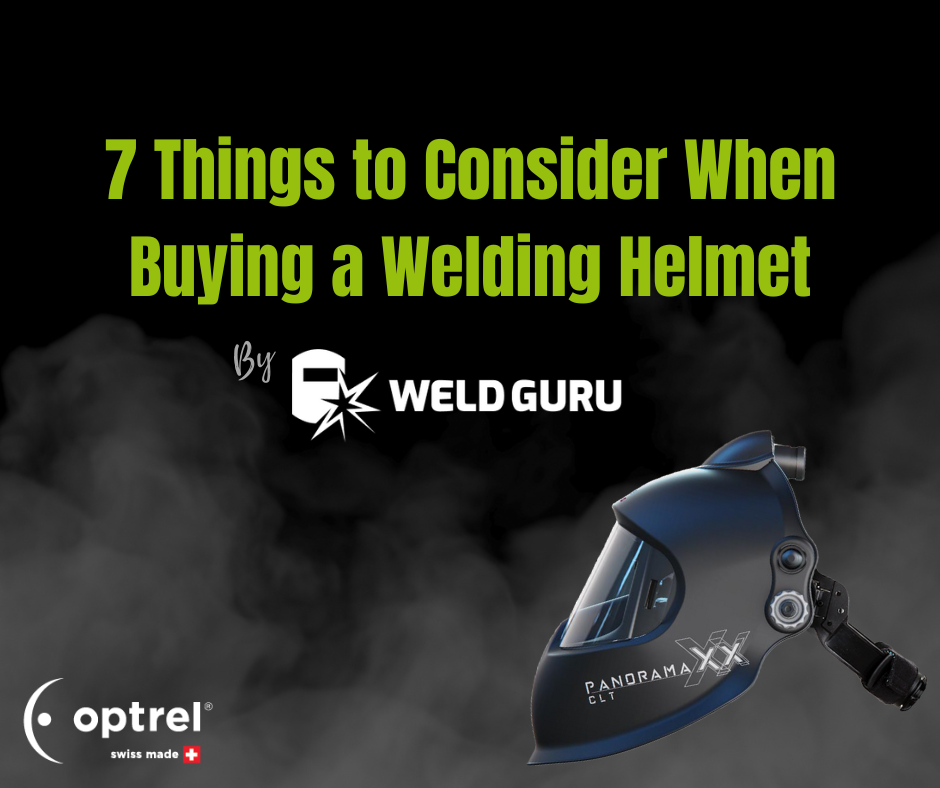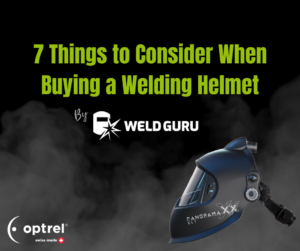5 Division Street, #35
East Greenwich, RI 02818 USA

Welding helmets have come a long way since the first arc welding helmet. While today’s helmets are feature-packed and much improved, all helmets are not created equal. There are many variables to consider when selecting a hood. In this article, the guys over at WeldGuru give us the top 7 factors to consider before pressing the “buy” button.
what to look for in a welding helmet
First things first, your welding helmet must fit properly. While this sounds like a no-brainer, a proper fit is essential for both safety and comfort. To figure out if your helmet fits properly, ask yourself the following questions:

When selecting a welding helmet, the viewing area is an essential component. Also called the field of vision, the viewing area is how much visibility you have from behind the lens. Welding hoods offer various viewing area sizes. What to look for depends on a few factors including your welding environment, the type of welding you do and your personal preference.
Many welders prefer a large viewing area as it offers a better view of the arc, puddle, and workpiece. If you are a hobbyist, a single viewing pane might suffice. A smaller viewing area can offer greater concentration, which may be advantageous for TIG welders. It’s also typically less expensive than a helmet with a large field of view. In contrast, hoods with larger viewing areas offer a bigger view of the work environment, allowing you to see mistakes and self-correct.
When fabricating or performing out-of-position work, a larger area, often called a panoramic view, provides greater visibility of your welding project and your environment. The Panoramaxx CLT gives a wide true-color view of the weld pool to help reduce eye strain and improve performance. Additionally, the high-resolution Panoramaxx lens allows you to see more clearly, making it easier to detect discoloration and imperfections. For this reason and many others, we rated the Panoramaxx CLT the best welding helmet, over at WeldGuru.
The clarity of your lens is so important. It becomes even more crucial if you’re welding professionally or for long hours as a clear lens is thought to prevent fatigue and increase productivity. Superior lens clarity also makes it easier to spot problems as you weld, before they get out of hand.
Lens clarity is designated by a rating system. A rating of 1/1/1/1 describes perfect optical clarity—an undistorted view from behind the lens.
Aside from the ranking, other factors can hinder clarity, including:
While auto-darkening lenses aren’t new, they are considerably newer than passive lenses. Optrel was one of the welding industry’s original inventors of auto-darkening filters (ADFs). An ADF lens does exactly as the name states; it darkens automatically when you weld or strike an arc, eliminating the need to flip the hood up and down.
Passive lenses stay fixed at a certain shade, regardless of the environment or brightness. Hobbyist welders or those who don’t weld often might choose a fixed shade lens as they are usually less expensive.
There are two types of ADFs. The less common is a fixed shade, that auto-darkens to a fixed shade. The more common ADF is a variable shade. This allows you to select the appropriate shade level, depending on the intensity of the arc.
Shade numbers are categorized on a sliding scale called a DIN rating. This German industrial standard is used worldwide to gauge the light transmission filter level. Darker filters have higher DIN numbers and block more radiation than lighter filters with lower DIN numbers.
ADFs are much easier to use overall, especially when welding in low-light conditions. If you’re looking for a variable shade welding helmet, check out the optrel Crystal 2.0. This welding hood automatically adapts to the welding arc and changing light conditions. The ultra-bright viewing area provides a clear view of weld puddle and reduces eye strain and fatigue.
If you’ve ever used an uncomfortable welding helmet, you know how frustrating it is. If the hood doesn’t fit right, lacks sufficient ventilation or weighs a ton, the entire welding experience hits different—and not in a good way.
There are many different helmets available that offer comfort and safety. One of the best examples of this is the Panoramaxx CLT, mentioned throughout this article. The Isofit headgear in the Panoramaxx is widely hailed as the most comfortable headgear on the market. Moreover, the patented nose cutout design ensures your helmet will not fog up easily. And, despite its massive viewing area, it’s also one of the lightest helmets available.
When the topic of overhead welding comes up, typically someone in the room advises you to avoid overhead welding at all costs. For obvious reasons, gravity is not your friend when it comes to welding. Still, there are times when overhead welding is necessary. What I’m about to say might surprise you…the majority of helmets on the market are not approved for overhead welding.
The good news? All of the helmets in optrel’s sphere series are approved for overhead welding, including:
One of the best features of optrel helmets is the spherical design. The spherical design of these helmets prevents slag and debris from burning a hole in your lens. Instead of filler material or metal slag sticking to your hood, the debris rolls off the lens of your helmet, protecting your eyes and face.
One of the coolest features available in many optrel helmets is the Shadetronic feature. Shadetronic is unlike anything available on the market. This built-in sensor automatically changes the shade level of your lens based on the intensity of light it detects.
Other helmets require you to adjust the shade level manually. Manual shade adjustment means you need to know the exact shade level you need. If you’re like most welders, you’ll go for a shade that feels right, based on your personal preference. This strategy works until it doesn’t. The problem is, you won’t know if your shade level provides adequate protection until it’s too late.
If you weld at a higher amp than your shade level protects for, you’re out of the range of protection. In the short term, you’ll experience fatigue. In the long-term, a lack of sufficient protection has been proven to damage the eyes irreversibly.
One school of thought is to always weld at a higher shade level, for instance, shade level 13. The disadvantage to this is the strain it puts on your eyes when you weld at lower amps and everything becomes dark. This can increase the risk of future eye problems.
With Shadetronic, you’ll always get the right shade protection and clarity. Automatic shade level adjustment helps boost productivity and reduce fatigue. This patented technology is available in the Panaromaxx range of helmets, the Crystal 2.0 and the e684.
When it comes to choosing a welding helmet, the most important factor is you. If you’re like most welders, you’ll start out with a bottom-of-the-line helmet, something you pick up at the local hardware store just to get by. As you progress in your career, you’ll begin to understand the challenges inherent in cheap helmets. In addition to the 7 key features of a welding helmet that we listed above, a few other things to consider include:
We hope this article helps you better understand what to look for when buying a welding helmet. If you have a specific question, contact us at [email protected].
5 Division Street, #35
East Greenwich, RI 02818 USA